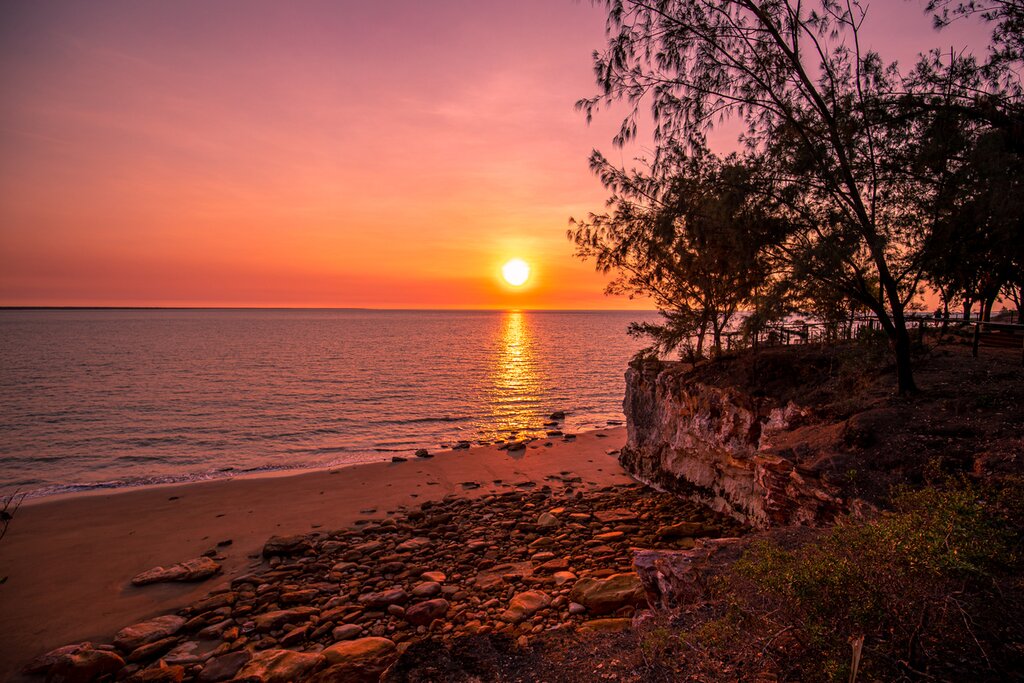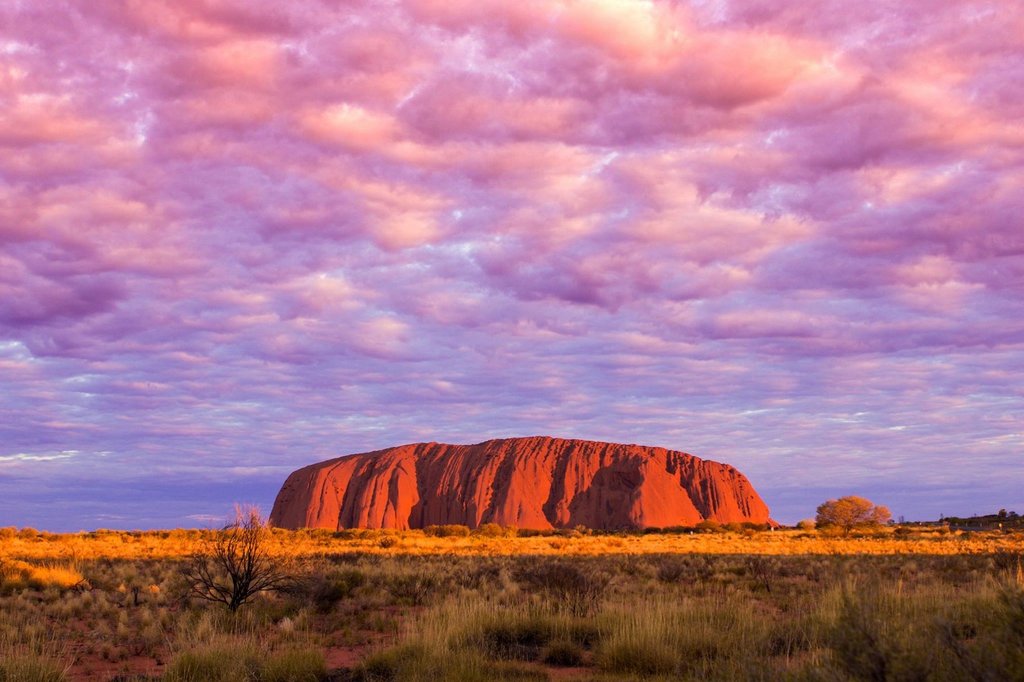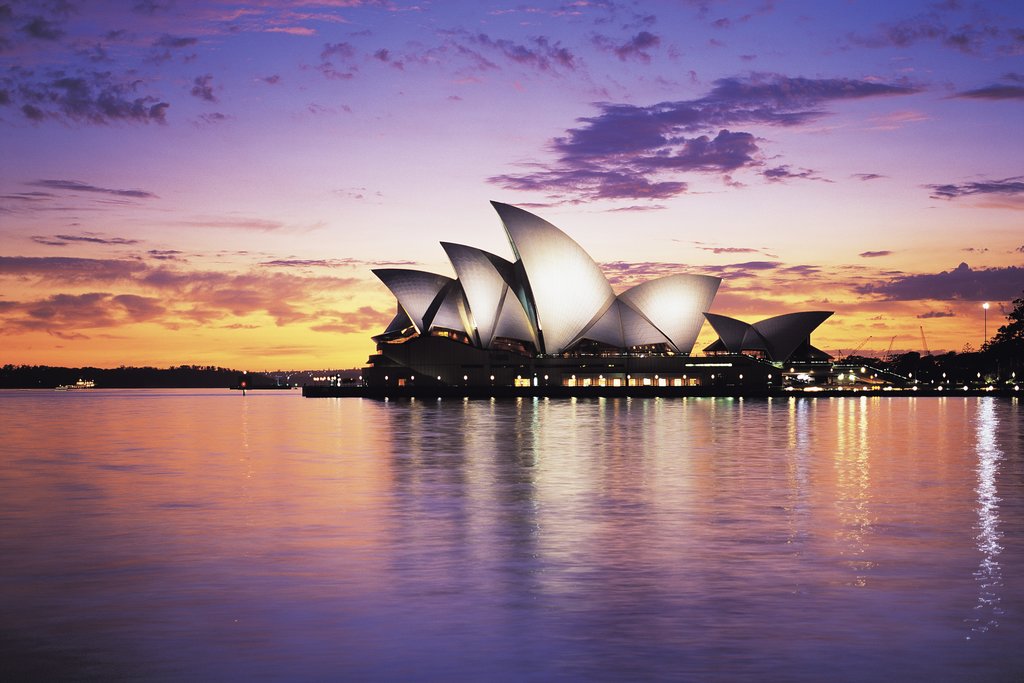Highlights
- Dive and snorkel among rays, turtles, and fish in the Great Barrier Reef
- Experience some of the best sunsets in the world on the beaches of Darwin
- Tour stunning waterfalls and magnetic termite mounds in Litchfield National Park
- Drive to Franz Josef Glacier and ride a helicopter onto the glacier
- Admire the art deco architecture of Napier, a city rebuilt after a 1930s earthquake
Brief Itinerary
| Day | Highlights | Overnight |
|---|---|---|
| Day 1 | Arrive in Cairns | Cairns |
| Day 2 | Free Day in Cairns | Cairns |
| Day 3 | Drive to Cape Tribulation, Dreamtime Walk | Cape Tribulation |
| Day 4 | Drive Back to Cairns via Palm Cove | Cairns |
| Day 5 | Free day in Cairns | Cairns |
| Day 6 | Fly to Darwin | Darwin |
| Day 7 | Explore Darwin | Darwin |
| Day 8 | Tour Litchfield National Park's Waterfalls | Darwin |
| Day 9 | Fly to Uluru | Uluru |
| Day 10 | Explore Uluru & Field of Light Dinner | Uluru |
| Day 11 | Fly to Sydney, Sunset Dinner Cruise | Sydney |
| Day 12 | Free Day in Sydney | Sydney |
| Day 13 | Fly to Christchurch | Christchurch |
| Day 14 | Drive to Franz Josef / Waiau | Franz Josef Glacier |
| Day 15 | Explore Franz Josef Glacier / Kā Roimata o Hine Hukatere | Franz Josef Glacier |
| Day 16 | Drive to Queenstown | Queenstown |
| Day 17 | Fly to Wellington, Explore | Wellington |
| Day 18 | Drive to Napier | Napier |
| Day 19 | Drive to Rotorua, Te Pā Tū Māori Feast & Performance | Rotorua |
| Day 20 | Drive to Auckland via Matamata | Auckland |
| Day 21 | Depart Auckland |
Detailed Itinerary
Day 1: Arrive in Cairns

Welcome to Cairns! Located on the northeastern coast of Far North Queensland, Cairns serves as the gateway to the Great Barrier Reef, the Wet Tropics of Queensland, and the Atherton Tableland. This area, known as "where the rainforest meets the reef," is the traditional homeland of the Yidinji people and was colonized by gold-seeking Europeans in the 19th century. Nowadays, it's a major tourist hub for its access to multiple UNESCO World Heritage Sites and its bustling Esplanade fit with a swimming lagoon.
Day 2: Free Day in Cairns

On your free day in Cairns, you can stay in town and admire the aquatic animals at the Cairns Aquarium or head just outside the city to tranquil seaside villages and palm-fringed beaches like Trinity and Clifton. To really get out of town, opt for a 4WD tour of Daintree National Park, the oldest rainforest ecosystem on earth, visit the jade rivers at Mossman Gorge, or the stunning Cape Tribulation coastal headland. Keep an eye out for endemic animals like kangaroos and cassowaries on your travels.
To take advantage of Cairns' proximity to nature, ride the Skyrail Rainforest Cableway and the Karanda Scenic Railway. The Skyrail covers 4.7 miles (7.5 km), about 13 feet (4 m) over the treetops of Barron Gorge National Park in the Wet Tropics, with stops at Red Peak and Barron Falls. Your last stop is Kuranda, a small village within the forest where you'll board the railway for the return journey. You'll see stunning waterfalls and other ancient sites as you head through the trees back down to sea level.
Day 3: Drive to Cape Tribulation, Dreamtime Walk

Today, follow Captain Cook Highway north to Cape Tribulation, a coastal headland within Daintree National Park. Drive north through Palm Cove to Port Douglas. Here, you can stop, stretch your legs on Four Mile Beach or pop over to Rex Lookout for stunning views of the Coral Sea. Then, drive past Mossman Gorge and ferry across the Daintree River before finally driving through the green canopy of the rainforest along Cape Tribulation Road to reach your destination.
Day 4: Drive Back to Cairns via Palm Cove

Head south on the Captain Cook Highway back to Cairns from Cape Tribulation. If you need a break along the way, stop at Port Douglas for plenty of options for lunch, coffee, or snacks. The highway follows the Coral Sea to Palm Cove, where you might stop for a swim on Palm Cove Beach or stroll on the jetty. There's no shortage of other beaches for you to visit if you have the time, like Yorkeys Knob, Trinity Beach, and Clifton Beach.
One of the longest-running tourist attractions you could stop at on your way is Hartley's Crocodile Adventure. Originally opened in 1934, the former teahouse for tired motorists is now a busy ecotourism center known for its mix of entertainment and education, particularly in its well-known Crocodile Attack Show. During your visit, you can see crocs as well as cassowaries, snakes, emus, and koalas.
Day 5: Free day in Cairns

On your free day today, you'll want to checkout the Great Barrier Reef, Cairns biggest draw. You could explore the Outer Great Barrier Reef from the air and the water with the Down Under Cruise and Dive. First, head out to the reef on a yacht and spend over five hours snorkeling or sunbathing on the deck. After, take off from Hasting Reef for a 10-minute helicopter ride over the water to appreciate the sheer size of the Great Barrier Reef.
Another option, Quicksilver, offers more than one way to see the reef. Its catamaran takes you to the reef, where you can snorkel among fish, sea turtles, and rays. This time, instead of a helicopter ride, you can go for a spin in a semi-submersible craft to enjoy all the action around the coral reef without getting wet.
Day 6: Fly to Darwin

Drive from your accommodation to the Cairns Airport, where you'll drop off your rental car and board a quick flight to say hello to Darwin. On arrival to the capital city of the Northern Territory, you'll be met by a private driver and dropped off in your new accommodation.
If there's time post your arrival, head out and explore the city! For nature lovers, a visit to Crocosaurus Cove is a can't-miss—more crocodiles than anywhere else in the world call the Northern Territory home. Or, go for a walk through the George Brown Darwin Botanic Gardens to learn more about the area's tropical climate and history.
Day 7: Explore Darwin

Darwin has no shortage of activities. With a tropical climate and scenic coast, it's the perfect place to walk along the beach—stop by the Mindil Beach Sunset Market to browse the stalls. If you want to spend the evening on dry land, visit the Deckchair Cinema, affectionately known as "The Deckie," for an outdoor movie screening.
As the city serves as the gateway to Litchfield National Park, take to the skies on a helicopter tour to fully appreciate it's over 549 square miles (1,500 sq km) of verdant woodland and tropical monsoonal vine forest. You'll fly over the Tabletop Range, a plateau made of sandstone that has eroded over time to form the singular landscape of the park. From rock formations and monsoon-fed streams to tall waterfalls cascading into clear swimming holes, you'll see all that Litchfield offers on this memorable tour.
Alternatively, you might like to join Darwin Gourmet Tours for a three-hour walking tour of the city. You'll try tasting plates from a rotating list of restaurants, like Hanuman, Phat Mango, Aboriginal Bush Traders, Bannsang, and more where you'll discover many chefs emphasize locally sourced ingredients. Your guide will point out cultural and historic landmarks along the way, like street art incorporating augmented reality technology.
Day 8: Tour Litchfield National Park's Waterfalls

Litchfield National Park is known for its towering waterfalls and swimming holes, but it's home to much more than that. The park, the traditional homeland of several First Nations peoples, hosts monsoon rainforests, sacred sites, magnetic termite mounds, and hundreds of native plants and animals. Take a full-day tour of some of the best parts of the park today, like Tolmer, Florence, and Wangi Falls. Stop at neighboring Howard Springs Nature Park to visit and feed wildlife like barramundi fish.
Day 9: Fly to Uluru

Today, fly south from Darwin to Uluru for the next part of your trip. A private transfer will collect you from your accommodation and drive you to the airport for your flight. Another transfer will pick you up from Ayers Rock Airport to take you to your accommodations. While you're here, get to know the area by taking a scenic flight or hiking along one of many trails.
Day 10: Explore Uluru & Field of Light Dinner

Spend the day in Uluru-Kata Tjuta National Park, home to its namesake red sandstone monolith, standing 1,142 feet (348 m) over the desert landscape. Of course, you can spend your time exploring and learning about Uluru, one of the most sacred sites in Australia for the Aṉangu people, particularly the Pitjantjatjara. But the area is also home to art galleries of Aṉangu art, world-class restaurants, and natural springs and rock caves.
Take a guided tour around the park to hear how Uluru and its surrounding Red Centre deserts are intertwined with local First Nations stories and history. This guided walk will take you past indigenous flora and fauna, ancient First Nations rock art, and the sandstone monolith itself. Follow a trail to the Mutijulu Waterhole, a sacred freshwater spring and site of an important First Nations origin story about Kunya and Liru.
Later tonight, experience a once-in-a-lifetime dinner when you dine outside in sight of the Field of Light art installation with Uluru as a backdrop. As the sun sets over the desert, enjoy canapés and a selection of wine and beer. Once darkness falls, the LEDs powering 527,431 square feet (49,000 sq m) of flowerlike glass spheres light up in a magical multicolor display. Enjoy a three-course meal, learn about the constellations shining in the open air above, and walk among the glimmering light display before the night is over.
Day 11: Fly to Sydney, Sunset Dinner Cruise

Day 12: Free Day in Sydney

You'll have a free day today to explore Sydney at your own pace. In the morning, consider making your way down to the BridgeClimb to reach the summit of the Sydney Harbour Bridge—440 feet (134 m) above sea level—for an uninterrupted panorama of the city and its surroundings. In the afternoon, take the bus or ferry to Bondi Beach or Manly Beach for a little sunbathing and a surf lesson, or head to the Nicholson Museum, home to the most extensive collection of antiquities in Australia and the Southern Hemisphere.
For something with a bit more structure, take a half-day tour of the best of Sydney's iconic landmarks. Step inside the Sydney Opera House for a guided tour of the behind-the-scenes areas the general audience doesn't get to see. Spot the sprawling landscape of Hyde Park, the twin spires of St Mary's Cathedral, the Georgian facade of New South Wales's Parliament House, and the columns of the Art Gallery of New South Wales, ending the tour at Bondi Beach in the east.
Day 13: Fly to Christchurch

Day 14: Drive to Franz Josef / Waiau

Day 15: Explore Franz Josef Glacier / Kā Roimata o Hine Hukatere

Franz Josef / Waiau, a small town settled on the Waiho River among rainforests and the mountains of the Southern Alps, is known for the 7-mile-long (12 km) Franz Josef Glacier / Kā Roimata o Hine Hukatere walk. The glacier's terminal face or end point is just 3 miles (5 km) from the town, making it an easy stop while you're in here.
To get closer to the glacier, consider taking a helicopter tour. Many tours in the area fly over Franz Josef Glacier / Kā Roimata o Hine Hukatere and nearby Fox Glacier / Te Moeka o Tuawe, which clocks in at 8 miles (13 km) long. You'll not only see these two famous glaciers from the air, but even land at the head (top) of one of them to truly appreciate the scale of these rivers of ice.
You can just as easily enjoy the town's namesake glacier from land. Dropping quickly from over 8,200 feet (2,500 m) above sea level to just 980 feet (300 m) above sea level, Franz Josef Glacier / Kā Roimata o Hine Hukatere is one of the most accessible in New Zealand, so consider a walking tour of the area. In the podocarp forest surrounding the glacier, you'll see rivers, snails, mushrooms, and orchids, among other wildlife—look high above the forest to spot goatlike chamois or tahrs on the mountains.
Day 16: Drive to Queenstown

There are so many worthy detours along the route to Queenstown that you'll want to set aside the whole day for the drive. As you head south along the coast, stop at Fox Glacier / Te Moeka o Tuawe and Knights Point Lookout to spot elephant seals. Then, cross the mighty Haast River before turning inland, climbing through mountains dotted with waterfalls. Stop for a walk to the Blue Pools near Makarora before reaching Wānaka, a lakeside resort town, and follow Crown Range Road into Queenstown.
Day 17: Fly to Wellington, Explore

Your journey today takes you to New Zealand's North Island. Drop your rental car off at the Queenstown Airport and fly to Wellington, the capital city. There's no shortage of things to do while you're in town. Explore via the City to Sea Walkway that cuts across the city streets to the coast. Along the way, stop by The Beehive, the executive wing of the country's parliament buildings, the lovely Botanic Gardens, or the world-class Te Papa National Museum.
Day 18: Drive to Napier

Drive four hours northeast from Wellington today to reach Napier, the art deco capital of New Zealand. Along the way, stop in Greytown, named New Zealand's Most Beautiful Small Town 2017, for its well-restored Victorian architecture. A little later, consider a pit stop in Masterton, another small town where sheep shearers compete in the Golden Shears competition. Cross into the Hawkes Bay Region, where you can rest at Havelock North before continuing to Napier.
Enjoy a ride through the scenic vineyards of the Hawkes Bay region on this guided, interactive winery tour. Once you arrive at one of the region's boutique wineries, you'll get to try a classic tasting plus wine with dinner, a dessert wine, and even a glass of Champagne you can sip as the sun sets. From the 1,309-foot (399 m) vantage point of Te Mata Peak, watch the sun dip in the sky as the lights of the Twin Cities, Napier and Hastings, come to life below.
Day 19: Drive to Rotorua, Te Pā Tū Māori Feast & Performance

Head north from Napier across the Ahiminawa Ranges to arrive in Taupō, a town that sits on New Zealand's largest lake, Lake Taupō. Continue to the nearby Huka Falls spilling into the Waikato River; get up close to the spray with a ride on the Huka Jet. As you near Rotorua, a city famous for geothermal activity, you'll start seeing boiling pools and seaming vents, like those in the volcanic reserve Craters of the Moon. After that pit stop, make your way through the Waimungu Valley before arriving in Rotorua.
In the evening, you'll have a chance to experience the rich Māori culture that defines this region of New Zealand. Te Pā Tū (formally Tamaki Māori Village), New Zealand's most awarded cultural attraction, invites manuhiri (guests) to a knowledge-sharing event centered around a three-course feast. During the four-hour celebration, you'll learn about Māori history, traditions, and culture through food, performance, and stories.Day 20: Drive to Auckland via Matamata

Head out from the geysers of Rotorua and drive past the rolling hills of the Waikato Region on your way to Matamata. This small town, nestled in the emerald hills made famous by "The Lord of the Rings" and "The Hobbit" movie trilogies, hosts the fully intact Hobbiton set. Besides being the setting for famous films, rural Matamata is also well known for breeding and training thoroughbred horses, so you'll be sure to see plenty of them on your way into town.
The must-do activity around here is taking a tour of the Hobbiton set. Your guide will show you around the 12-acre (4.8 ha) site of the Shire, including the Hobbit holes, the Mill, and the Green Dragon Inn, where you can try a drink from the Southfarthing range of beer, cider, and ginger beer surrounded by the sights and sounds of Middle-earth.
Day 21: Depart Auckland

It's time to say goodbye to New Zealand and Australia. Drop your rental car off at the airport depot before catching your flight back home. Safe travels!


